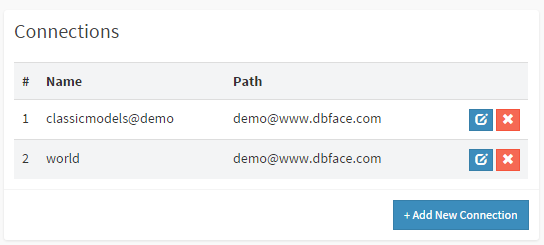MySQL or MariaDB
Connect to MySQL or MariaDB in DbFace
DbFace needs to get data from your database to display and manipulate. So DbFace needs to know how to connect to your database servers.
DbFace supports MySQL, PostgreSQL, Clickhouse, SQL Server, Oracle, Firebird/Interbase, CUBRID, MongoDB and other SQL/NOSQL database servers. You can also upload CSV files as data sources. For other data sources ( in-house data), you can create your own API connector or Data Source Plugin to make it work with DbFace.
Ensure that the database is publicly addressable and currently up & running.
Verify that the database is not hosted on a local machine. DbFace cannot connect to databases hosted on local machines (e.g. laptops, PCs, etc.).
Ensure that DbFace supports the database type attempting to be connected. A list of supported integrations is available here.
To create a connection to your database, please login DbFace with the Administrator account, find the “Connections” section in the dashboard, there will list all the database connections you have created.

Click “Add new connection” button to enter “create a database connection” page:
We are always working on to support more database types.
Some database drivers (such as IBM DB2, 4D) might require a full DSN string to be provided. If that is the case, you should use the ‘dsn’ configuration setting, as if you’re using the driver’s underlying native PHP extension, like this:
// PDO
$db['default']['dsn'] = 'pgsql:host=localhost;port=5432;dbname=database_name';
// Oracle
$db['default']['dsn'] = '//localhost/XE';
Log in as Administrator, find the “Connections” section in the dashboard, click on “Edit” button, then enter the database connection editing page.
!!! warning If your database schema changed, all applications will be affected.
Log in as Administrator, find the “Connections” in dashboard page, click “Delete” button, After confirmation, the database connection will be removed.
!!! warning “Be careful” Deleting a database connection will delete all applications using this database connection!
For API Connector, DbFace provides a quick way to sync the remote data to DbFace server on the fly. After tapped the “Sync” button, DbFace will get the updated data from your server via the API Connector.

Click the “Select” button to change the default database connection. DbFace will only show applications that using default connection in the left menu.
If you want to show all applications, you can change the option at System Settings page.
For MySQL, CSV Files, API Connector data sources, DbFace provide database structure management tool.
Click here to learn more information about Structure Management Tool.
You can test SQL queries in SQL workshop, and save them as favorite. You can pick a tested SQL query while building an application.
Click here to learn more information about SQL Workshop.
SQL Terminal provides you a console emulator to execute SQL query quickly.
Click here to learn more information about SQL Terminal.
Connect to MySQL or MariaDB in DbFace
Connect to PostgreSQL in DbFace
Connect to Clickhouse in DbFace
Connect to Microsoft SQL Server in DbFace
Connect to Oracle in DbFace
Connect to IBM in DbFace
Connect to MongoDB in DbFace
Connect to SQLite3 in DbFace
Connect to Presto Db in DbFace
Connect to Google BigQuery in DbFace
Connect to Firebird in DbFace
Connect to Cubrid in DbFace
Connect to Apache HBase in DbFace
Connect to Apache Cassandra in DbFace
Connect to Amazon DynamoDB in DbFace
Connect to CSV Files in DbFace
Connect to API Connector in DbFace
Plugin Application Data in DbFace
Connect to Microsoft Access in DbFace
DbFace internal warehouse
Was this page helpful?
Glad to hear it! Please tell us how we can improve.
Sorry to hear that. Please tell us how we can improve.